[English] 日本語
 Yorodumi
Yorodumi- PDB-7bzt: Cryo-EM structure of mature Coxsackievirus A10 in complex with KR... -
+ Open data
Open data
- Basic information
Basic information
| Entry | Database: PDB / ID: 7bzt | ||||||||||||||||||||||||||||||||||||||||||||||||||||||
|---|---|---|---|---|---|---|---|---|---|---|---|---|---|---|---|---|---|---|---|---|---|---|---|---|---|---|---|---|---|---|---|---|---|---|---|---|---|---|---|---|---|---|---|---|---|---|---|---|---|---|---|---|---|---|---|
| Title | Cryo-EM structure of mature Coxsackievirus A10 in complex with KRM1 at pH 7.4 | ||||||||||||||||||||||||||||||||||||||||||||||||||||||
 Components Components |
| ||||||||||||||||||||||||||||||||||||||||||||||||||||||
 Keywords Keywords | VIRUS / Picornavirus / Coxsackievirus A10 / pH 7.4 / mature particle / KRM1 / complex | ||||||||||||||||||||||||||||||||||||||||||||||||||||||
| Function / homology |  Function and homology information Function and homology informationSignaling by LRP5 mutants / Negative regulation of TCF-dependent signaling by WNT ligand antagonists / negative regulation of axon regeneration / cell communication / negative regulation of ossification / limb development / regulation of canonical Wnt signaling pathway / symbiont-mediated suppression of host cytoplasmic pattern recognition receptor signaling pathway via inhibition of MDA-5 activity / picornain 2A / symbiont-mediated suppression of host mRNA export from nucleus ...Signaling by LRP5 mutants / Negative regulation of TCF-dependent signaling by WNT ligand antagonists / negative regulation of axon regeneration / cell communication / negative regulation of ossification / limb development / regulation of canonical Wnt signaling pathway / symbiont-mediated suppression of host cytoplasmic pattern recognition receptor signaling pathway via inhibition of MDA-5 activity / picornain 2A / symbiont-mediated suppression of host mRNA export from nucleus / TCF dependent signaling in response to WNT / symbiont genome entry into host cell via pore formation in plasma membrane / picornain 3C / T=pseudo3 icosahedral viral capsid / negative regulation of canonical Wnt signaling pathway / ribonucleoside triphosphate phosphatase activity / host cell cytoplasmic vesicle membrane / Wnt signaling pathway / transmembrane signaling receptor activity / nucleoside-triphosphate phosphatase / channel activity / monoatomic ion transmembrane transport / DNA replication / RNA helicase activity / endocytosis involved in viral entry into host cell / symbiont-mediated activation of host autophagy / RNA-directed RNA polymerase / cysteine-type endopeptidase activity / viral RNA genome replication / neuronal cell body / RNA-directed RNA polymerase activity / apoptotic process / DNA-templated transcription / virion attachment to host cell / host cell nucleus / structural molecule activity / signal transduction / proteolysis / RNA binding / zinc ion binding / ATP binding / membrane / plasma membrane Similarity search - Function | ||||||||||||||||||||||||||||||||||||||||||||||||||||||
| Biological species |  Homo sapiens (human) Homo sapiens (human)  Coxsackievirus A10 Coxsackievirus A10 | ||||||||||||||||||||||||||||||||||||||||||||||||||||||
| Method | ELECTRON MICROSCOPY / single particle reconstruction / cryo EM / Resolution: 3 Å | ||||||||||||||||||||||||||||||||||||||||||||||||||||||
 Authors Authors | Cui, Y. / Peng, R. / Song, H. / Tong, Z. / Gao, G.F. / Qi, J. | ||||||||||||||||||||||||||||||||||||||||||||||||||||||
| Funding support |  China, 1items China, 1items
| ||||||||||||||||||||||||||||||||||||||||||||||||||||||
 Citation Citation |  Journal: Proc Natl Acad Sci U S A / Year: 2020 Journal: Proc Natl Acad Sci U S A / Year: 2020Title: Molecular basis of Coxsackievirus A10 entry using the two-in-one attachment and uncoating receptor KRM1. Authors: Yingzi Cui / Ruchao Peng / Hao Song / Zhou Tong / Xiao Qu / Sheng Liu / Xin Zhao / Yan Chai / Peiyi Wang / George F Gao / Jianxun Qi /  Abstract: KREMEN1 (KRM1) has been identified as a functional receptor for Coxsackievirus A10 (CV-A10), a causative agent of hand-foot-and-mouth disease (HFMD), which poses a great threat to infants globally. ...KREMEN1 (KRM1) has been identified as a functional receptor for Coxsackievirus A10 (CV-A10), a causative agent of hand-foot-and-mouth disease (HFMD), which poses a great threat to infants globally. However, the underlying mechanisms for the viral entry process are not well understood. Here we determined the atomic structures of different forms of CV-A10 viral particles and its complex with KRM1 in both neutral and acidic conditions. These structures reveal that KRM1 selectively binds to the mature viral particle above the canyon of the viral protein 1 (VP1) subunit and contacts across two adjacent asymmetry units. The key residues for receptor binding are conserved among most KRM1-dependent enteroviruses, suggesting a uniform mechanism for receptor binding. Moreover, the binding of KRM1 induces the release of pocket factor, a process accelerated under acidic conditions. Further biochemical studies confirmed that receptor binding at acidic pH enabled CV-A10 virion uncoating in vitro. Taken together, these findings provide high-resolution snapshots of CV-A10 entry and identify KRM1 as a two-in-one receptor for enterovirus infection. | ||||||||||||||||||||||||||||||||||||||||||||||||||||||
| History |
|
- Structure visualization
Structure visualization
| Movie |
 Movie viewer Movie viewer |
|---|---|
| Structure viewer | Molecule:  Molmil Molmil Jmol/JSmol Jmol/JSmol |
- Downloads & links
Downloads & links
- Download
Download
| PDBx/mmCIF format |  7bzt.cif.gz 7bzt.cif.gz | 209.4 KB | Display |  PDBx/mmCIF format PDBx/mmCIF format |
|---|---|---|---|---|
| PDB format |  pdb7bzt.ent.gz pdb7bzt.ent.gz | 163.3 KB | Display |  PDB format PDB format |
| PDBx/mmJSON format |  7bzt.json.gz 7bzt.json.gz | Tree view |  PDBx/mmJSON format PDBx/mmJSON format | |
| Others |  Other downloads Other downloads |
-Validation report
| Summary document |  7bzt_validation.pdf.gz 7bzt_validation.pdf.gz | 1019 KB | Display |  wwPDB validaton report wwPDB validaton report |
|---|---|---|---|---|
| Full document |  7bzt_full_validation.pdf.gz 7bzt_full_validation.pdf.gz | 1 MB | Display | |
| Data in XML |  7bzt_validation.xml.gz 7bzt_validation.xml.gz | 43.2 KB | Display | |
| Data in CIF |  7bzt_validation.cif.gz 7bzt_validation.cif.gz | 65.3 KB | Display | |
| Arichive directory |  https://data.pdbj.org/pub/pdb/validation_reports/bz/7bzt https://data.pdbj.org/pub/pdb/validation_reports/bz/7bzt ftp://data.pdbj.org/pub/pdb/validation_reports/bz/7bzt ftp://data.pdbj.org/pub/pdb/validation_reports/bz/7bzt | HTTPS FTP |
-Related structure data
| Related structure data |  30259MC  7bznC  7bzoC  7bzuC  7c4tC  7c4wC  7c4yC  7c4zC M: map data used to model this data C: citing same article ( |
|---|---|
| Similar structure data |
- Links
Links
- Assembly
Assembly
| Deposited unit | 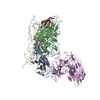
|
|---|---|
| 1 | x 60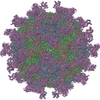
|
| 2 |
|
| 3 | x 5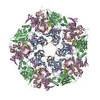
|
| 4 | x 6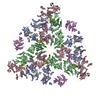
|
| 5 | 
|
| 6 | x 60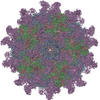
|
- Components
Components
-Capsid protein ... , 4 types, 4 molecules ABCD
| #1: Protein | Mass: 33204.332 Da / Num. of mol.: 1 / Source method: isolated from a natural source / Source: (natural)   Coxsackievirus A10 / References: UniProt: A0A0C5AWF6*PLUS Coxsackievirus A10 / References: UniProt: A0A0C5AWF6*PLUS |
|---|---|
| #2: Protein | Mass: 27783.105 Da / Num. of mol.: 1 / Source method: isolated from a natural source / Source: (natural)   Coxsackievirus A10 / References: UniProt: G0YPI2 Coxsackievirus A10 / References: UniProt: G0YPI2 |
| #3: Protein | Mass: 26187.623 Da / Num. of mol.: 1 / Source method: isolated from a natural source / Source: (natural)   Coxsackievirus A10 / References: UniProt: G0YPI2 Coxsackievirus A10 / References: UniProt: G0YPI2 |
| #4: Protein | Mass: 7464.104 Da / Num. of mol.: 1 / Source method: isolated from a natural source / Source: (natural)   Coxsackievirus A10 / References: UniProt: G0YPI2 Coxsackievirus A10 / References: UniProt: G0YPI2 |
-Protein / Non-polymers / Sugars , 3 types, 5 molecules E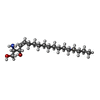



| #5: Protein | Mass: 41499.027 Da / Num. of mol.: 1 Source method: isolated from a genetically manipulated source Source: (gene. exp.)  Homo sapiens (human) / Production host: Homo sapiens (human) / Production host:  Homo sapiens (human) / References: UniProt: Q96MU8*PLUS Homo sapiens (human) / References: UniProt: Q96MU8*PLUS |
|---|---|
| #6: Chemical | ChemComp-SPH / |
| #7: Sugar |
-Details
| Has ligand of interest | Y |
|---|---|
| Has protein modification | Y |
| Sequence details | The genome sequence of chain A have been deposit in GenBank: MT263729 |
-Experimental details
-Experiment
| Experiment | Method: ELECTRON MICROSCOPY |
|---|---|
| EM experiment | Aggregation state: PARTICLE / 3D reconstruction method: single particle reconstruction |
- Sample preparation
Sample preparation
| Component | Name: Coxsackievirus A10 / Type: VIRUS / Entity ID: #1-#5 / Source: NATURAL |
|---|---|
| Source (natural) | Organism:   Coxsackievirus A10 Coxsackievirus A10 |
| Details of virus | Empty: NO / Enveloped: NO / Isolate: STRAIN / Type: VIRION |
| Buffer solution | pH: 7.4 |
| Specimen | Embedding applied: NO / Shadowing applied: NO / Staining applied: NO / Vitrification applied: YES |
| Vitrification | Instrument: FEI VITROBOT MARK IV / Cryogen name: ETHANE / Humidity: 100 % / Chamber temperature: 277 K |
- Electron microscopy imaging
Electron microscopy imaging
| Experimental equipment |  Model: Talos Arctica / Image courtesy: FEI Company | ||||||||||||||||
|---|---|---|---|---|---|---|---|---|---|---|---|---|---|---|---|---|---|
| Microscopy | Model: FEI TALOS ARCTICA | ||||||||||||||||
| Electron gun | Electron source:  FIELD EMISSION GUN / Accelerating voltage: 200 kV / Illumination mode: FLOOD BEAM FIELD EMISSION GUN / Accelerating voltage: 200 kV / Illumination mode: FLOOD BEAM | ||||||||||||||||
| Electron lens | Mode: BRIGHT FIELD | ||||||||||||||||
| Image recording |
|
- Processing
Processing
| Software | Name: PHENIX / Version: 1.17.1_3660: / Classification: refinement | ||||||||||||||||||||||||
|---|---|---|---|---|---|---|---|---|---|---|---|---|---|---|---|---|---|---|---|---|---|---|---|---|---|
| EM software | Name: PHENIX / Category: model refinement | ||||||||||||||||||||||||
| CTF correction | Type: PHASE FLIPPING AND AMPLITUDE CORRECTION | ||||||||||||||||||||||||
| 3D reconstruction | Resolution: 3 Å / Resolution method: FSC 0.143 CUT-OFF / Num. of particles: 28084 / Symmetry type: POINT | ||||||||||||||||||||||||
| Refine LS restraints |
|
 Movie
Movie Controller
Controller









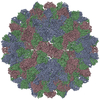


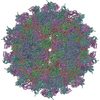
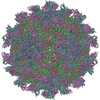
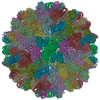
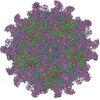

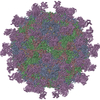
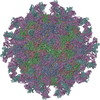
 PDBj
PDBj







